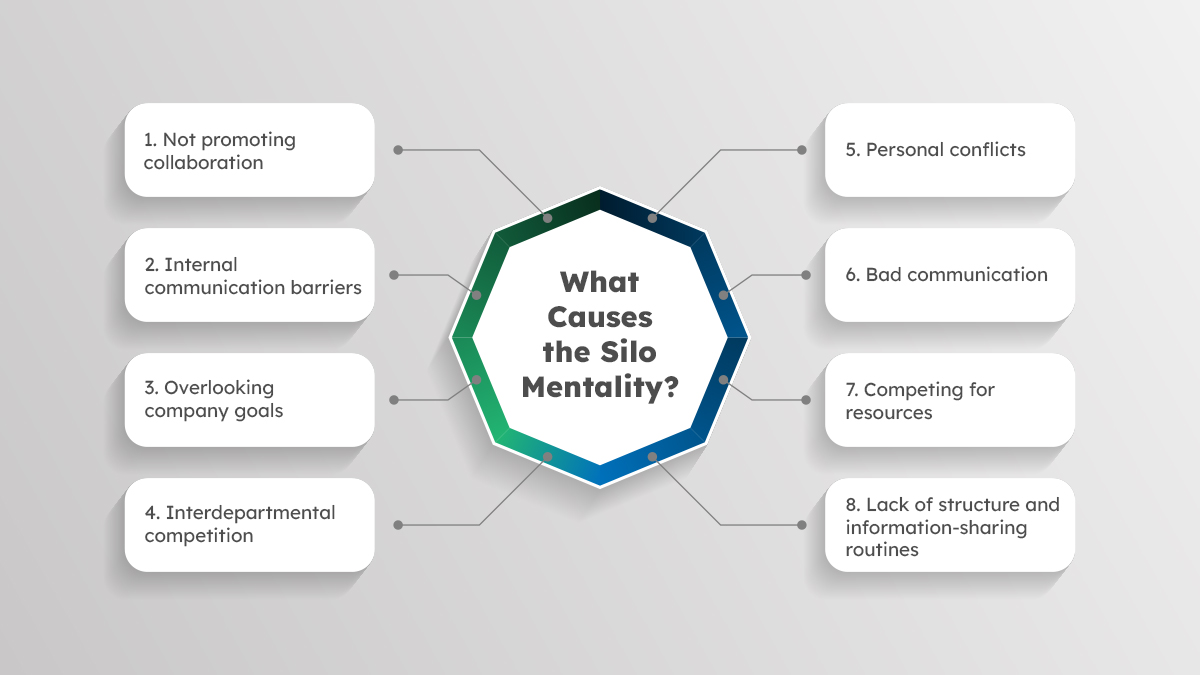Ever heard of the word ‘Silo’?
Silo is a term used for grain-storing containers. Where in the farmyards, these silos are protective in function; in the corporate environment, they act as antagonists to business growth.
If you have never heard of the silo mentality in the corporate world, you have stumbled upon the right page.
Here, in this blog, we will elaborate and reflect light on what the silo mentality is.
What Is the Silo Mentality?
Silo mentality is a behavior in a corporate environment that disables an effective exchange of information between diverse organizational departments. It could be intentional or unintentional. But whichever way, a silo mentality can severely damage the corporate culture, impeding the way to flourishing growth. It interrupts a streamlined workflow, creates informational barriers, and hampers business growth over time.
Continued for prolonged periods, it creates challenges in effective collaboration and teamwork, reducing entrepreneurial scalability, productivity, and progress.
However, silos in business seem quotidian in a company, addressing them on time can open new avenues for a company and assist them in achieving challenging projects with smooth collaboration among different teams/departments.
Learning about team collaboration and time management tools can significantly reduce the prevalence of the silo mentality in workplaces and bring organizational flow.
What Causes the Silo Mentality?
There are multifarious causes behind the silo mentality in organizations. However, the reasons may vary from organization to organization.
Large-scale companies have bigger teams and towering goals. Oftentimes, it is difficult to keep account of sharing valuable information with every member of the organization. Whereas small-scale companies may have other internal causes, such as departmental competition and inadequately developed systems that inbreed the silos in business.
The infographic given below displays several reasons with the potential to procreate the silo mentality in companies.

What Are the Impacts of the Silo Mentality?
The Silo mentality may seem an occupational and common phenomenon in workplaces but its impacts may be negative, severely hindering businesses’ end goals and long-term visions.
Less Agility & Adaptability
Silos in the business prevent organizations from adapting to rapid, continuous, and evolutionary strategies to gain a competitive advantage. It halts the innovation-driving approach and stops organizations from progressing and incorporating the latest capabilities into their workflow systematically.
Poor Decision-making
Due to duplicate and redundant work of negligible value, productivity takes the high road. Organizational silos in business limit the information to only one department, downgrading the decision-making capability of an organization.
Less Accountability
When crucial information is hoarded and sealed for personal benefits or unclear reasons, a lack of accountability spurs inside an organization. Soon, the ‘blame game’ becomes a sure-shot remedy for evading responsibilities, creating slumps in meeting long-term business objectives.
Inability to Express
The silo mentality is notorious for fostering more loyalty to one’s team instead of considering the company’s goals. It indirectly gives birth to a narrow-minded mentality that spawns selfishness and clique-oriented culture openly in a company. Unfortunately, it is contrary to an organization’s aims and objectives.
Distrust
The silo mentality pushes employees to distrust other teams and management because of the psychological boundaries employees draw themselves. It results in barred communication and more conflicts. Gradually, the imitation of the behavior by other teams creates more indifference between members and distorts the fraternity of the organization.
Lowered Morale
The silo mentality can be perceived as discriminative by other teams, and the workers unable to receive information may feel lowered and unacknowledged. If the silo mentality is continued for prolonged periods, it may trigger a sense of lowered morale and less importance than other employees.
Less Information
According to the Productivity Drain Research Report, businesses are losing thousands of productivity hours due to inaccessible information, resulting in assumptions-based corporate decisions. Silos in business is certainly one of the reasons, for decreasing access to information and creating productivity leaks.
Absence of Feedback
Working in silos limits the culture of feedback, suggestion, and constant learning and evolution. When resources like team members, essential tools, and insightful information are not known to all the members of a company, they end up doing redundant work, wasting time and effort. It negatively impacts the overall productivity of a company in the long term.
How Can Organizations Overcome the Siloed Mentality?
Bringing all the teams together on a unified platform can be daunting in the beginning. Gradually implementing modifications, one at a time, in systems, helps burst the bubble of the silo mentality.
Let’s look into strategies to overcome the siloed mentality as suggested by business leaders worldwide.
Educate and Encourage
Companies should educate employees about the importance of cross-functional collaboration. When two teams collaborate, they break the silos and achieve targets on time with the minimum effort. Training programs and knowledge sessions that have overlapped benefits for two or more teams can generate a sense of ‘togetherness’, leading to mitigation of reluctance while collaborating.
Cross-Functional Teams
Cross-functional teams consist of experts from different teams like sales, marketing, human resources, product development, and client relationship management to form a group that improves the coordination between the functional teams. These cross-functional teams are essential for success where knowledge, experience, and expertise from all spheres are required to collaborate and produce results together.
Updates and Information Influx
Knowledge silos can limit the power of an organization since a smooth flow of information is imperative for business progression. Companies should support regular knowledge transfer sessions for teams to acquire more information and utilize it to cultivate and capitalize on innovative ideas. For instance, marketing and sales teams have similar goals and should connect harmoniously to collaborate rather than compete. It will help an organization reach its targets faster.
Open Communication
Implementing policies that foster unrestricted communication between teams is essential. It can only be achieved with the straightforward exchange of concerns and solutions. Dissolving hierarchy and encouraging an open-door policy can be a great initiative. Asking for anonymous feedback, and promoting a growth-nurturing environment can bridge the gaps between the teams and allow them to be vocal enough to break open the departmental silos.
Collaborative Tools
Effective use of a project management tool helps get a bird’s eye view of the project and teams’ inclusion by senior executives and project managers. Project management tools are incredible for keeping every member updated and abreast with real-time changes by other members and stakeholders. Other tools facilitating closer connectivity among team members are Slack, WebEx, Asana, FlowDock, and Zoom. These tools ensure the teams have access to constant support from coworkers and collaborators.
The Bottom Line
The silo mentality is a major organizational gridlock. However, a company can easily overcome the organizational silos in business and nurture healthy and collaborative relationships between employees. This will mitigate communicational and perspective differences by utilizing more collaborative tools. Open communication is also vital for sharing valuable information and helping push the organization forward as a whole.
